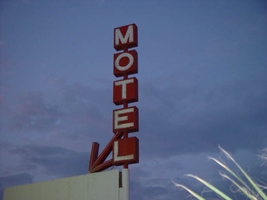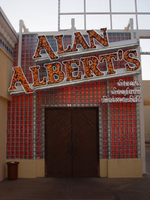Search the Special Collections and Archives Portal
Search Results
James Cashman Sr. Papers
Identifier
Abstract
The James Cashman Sr. Papers date from approximately 1890 to 1969 and contain correspondence, photographs, insurance records, and bank records related to Cashman and his businesses in Southern Nevada. The collection documents the lives of the Cashman family and their businesses in southern Nevada.
Archival Collection
Gary Sternberg Papers
Identifier
Abstract
The Gary Sternberg Papers are comprised of correspondence, publications, and videos documenting Sternberg's involvement with the Las Vegas Jewish community from 1983 to 2015. Organizations represented in the collection include Congregation Ner Tamid and the Holocaust Survivors Group of Southern Nevada. Also included are digital photographs of Sternberg in 2015 wearing his Caesars Palace dealer's uniform.
Archival Collection
Forever in Our Hearts Documentary
Identifier
Abstract
The collection is comprised of a short documentary film,
Archival Collection
Ken Hanlon Jazz Music Manuscripts
Identifier
Abstract
The Ken Hanlon Jazz Music Manuscripts (approximately 1975-1990) is comprised of jazz music compositions that were gathered by the Arnold Shaw Popular Music Research Center at the University of Nevada, Las Vegas (UNLV) in Las Vegas, Nevada. The collection includes several scores and arrangements from Hanlon's ensembles, including the UNLV Jazz Band, Seventy-Six Trombones Ensemble, and the Si Zentner Ensemble.
Archival Collection
Bill Campbell Costume Designs
Identifier
Abstract
The Bill Campbell Costume Designs (1954-1978) are comprised of original costume design sketches created by designer Bill Campbell for a number of Donn Arden's stage productions, including Pzazz!, Hello America, and Hello Hollywood Hello that were staged in the Crystal Room at the Desert Inn in Las Vegas, Nevada during the 1960s and 1970s. The collection also contains some sketches for other revues held in Los Angeles, California and Reno, Nevada. The majority of items in the collection are original drawings with attached fabric swatches; a number of items are xeroxed reproductions.
Archival Collection
Series V. Hughes Tool Company, 1912 to 1990
Level of Description
Scope and Contents
The Hughes Tool Company series (1912-1990) encompasses the administrative, financial, and legal management of Hughes Tool Company. Materials within the series depict Howard Hughes' control of the company; his film, aeronautics, electronics, and real estate ventures; and his lawsuits and United States Senate hearing. The series also includes research reports on the corporate history of Hughes Tool Company and its subsidiaries, copyright histories for films Hughes produced, and correspondence from Hughes' associates searching for reels of Hughes' films domestically and internationally.
Archival Collection
Collection Name: Howard Hughes Film Production Records
Box/Folder: N/A
Archival Component

Nathalie Martinez oral history interview: transcript
Date
Archival Collection
Description
Oral history interview with Nathalie Martinez conducted by Rodrigo Vazquez and Barbara Tabach on June 24, 2021 for Latinx Voices of Southern Nevada Oral History Project. Nathalie Martinez, one of the original members of the Latinx Voices project team, dicusses her personal history and the history of her parents who immigrated to the United States from Colombia and El Salvador. She shares her educational background and experiences working as an interviewer for the Latinx Voices project before its culmination and her graduation in 2021. Nathalie also talks about her work on the project's podcast and her work linguistically translating the interviews from Spanish to English.
Text

Transcript of interview with Lyn Robinson by Barbara Tabach, September 18, 2014
Date
Archival Collection
Description
One day in 2012, UNLV student Lyn Robinson spied a posting on the bulletin board for a photographer for the Sperling Kronberg Mack Holocaust Resource Center. She was an art major with a concentration on photography. She was also had a deep appreciation of the horror of the Holocaust and what the survivors she would take photos of had endured. Thus began a two year project, during which she took photos of over sixty survivors. Her images are preserved at UNLV Special Collections & Archives. Prints are displayed at the Sperling Kronberg Mack Holocaust Resource Center. On September 18, 2014, Lyn shared her work for this oral history recording. She is a native of Florida, daughter of a horticulturist father and pianist mother.
Text

Photographs of Happi Inn signs, Las Vegas (Nev.), 2002
Date
Archival Collection
Description
Site address: 3939 S Las Vegas Blvd
Sign details: The Happi Inn resides on the corner of Mandalay and Las Vegas Blvd, stretching east, ending at Gilles street. The property is the largest of the small roadside sites. The signage, however, is limited. Three pole signs and an internally lit cabinet comprise total signage. The two pole signs, being the tallest, reside on the north end of the property while a small vertical pole sign resides on the top of the building's roofline. The small internally lit cabinet sits over the drive, next to the main office.
Sign condition: Structure 3 Surface 4 Lighting 3 Notes: The structure of all the signs appear to be intact, with no visible, severe damage. Various lighting is out an all the signs, with the small roof line pole sign, no longer being lit. The internally lit cabinets on the sign within the pole sign furthest east, are no longer lit as well. The surfaces of the sign are intact, but are worn.
Sign form: Pylon; Fascia
Sign-specific description: Two pole style pylons, reside on the north end of the property. On the rear of the property on the corner of Mandalay Bay and Gilles Street, is a simple design. A single white, steel pole, supports three, two- sided cabinets stacked on top of each other to create the shape. A small white, horizontal, rectangular, cabinet, has a white face with "Office" painted in red text, and a red arrow pointing to the west. It sits slightly off center the center pole. A tall, thin, vertical, rectangular cabinet, is painted orange, and has the world "Motel," spelled in all capital, white neon letters. Centered on top of this cabinet, another internally lit cabinet, white cabinet, crowns the sign. The cabinet has a green face with white text spelling "Happi Inn" in all capital letters. The main pole sign for the property is similar to the previous piece, but a bit more elaborate. As the white pole rises up from the ground it is met with a pair of black, cabinets, sandwiching the north and south sides of the pole. The sign itself faces north south. The cabinets are white faced with text painted upon the surface. Above the two cabinets, a double-backed cabinet is crafted into an "L" shape, facing north, and facing south it would be a "J" shape. Either way it is a horizontal cabinet, which makes a horizontal turn to the east. The foot of the character curves down to a point, while the vertical section, runs up the west side of the white pole, which continues upward. The vertical surface contains the text "Motel" that is written horizontally downward in all capital, white, painted text. The graphic text is shadowed over with neon tubing. The horizontal section has the words "vacancy" written in white all capital text, with red neon lying over the surface. The top of the sign is crowned with a double backed, six sided, geometric cabinet. The surface is green written in capital, white text, with the word "Happi" written in an arched pattern, with "Inn" written horizontally below that. Over the entrance to the driveway, stretching into the east-end of the lot, is a small, internally lit cabinet, with rounded ends. The face of sign is green plastic with "Happi Inn" written in all capitals, in a two lined text. White, scroll-type designs, flank, both sides of the text. Just past the Psychic Sessions, palmistry establishment, actually standing on the corner of the building, a vertical pole sign, rises in the sky. I single red pole shoots upward a short distance, with five double-backed square cabinets being speared through the center. Each cabinet, also red, contains 1 letter from the word "Motel, in all capitals." The letters are overlaid with neon as well/ Pointing down toward the property, an angled arrow, crafted in the same fashion and material as the cabinet, is positioned just below the east side of the cabinet containing the letter "E."
Sign - type of display: Neon; Incandescent; Backlit
Sign - media: Steel; Plastic
Sign - non-neon treatments: Paint
Sign animation: Chasing, flashing, oscillating
Notes: the letters inside of the letters of the tower actually oscillate.
Sign environment: The Happi Inn is part of the distinctive section of the Strip comprised of older roadside motels, met with a few of the larger resort casinos. Facing west on the corner of Las Vegas Blvd and Mandalay Rd., the property resides in the shadow of Luxor. To the north, vacant land reaches until ended by the Tropicana property.
Sign - thematic influences: There appears to be no apparent theme associated with the Happi Inn other than the fact that it belongs to the style and genre of the roadside motel design seen throughout the southern end of the strip.
Surveyor: Joshua Cannaday
Survey - date completed: 2002
Sign keywords: Chasing; Pylon; Fascia; Neon; Incandescent; Backlit; Steel; Plastic; Paint
Mixed Content

Photographs of Alan Albert's signs, Las Vegas (Nev.), 2002
Date
Archival Collection
Description
Site address: 3763 S Las Vegas Blvd
Sign details: Following the alleyway created between the Walgreen's and Fatburger establishments, you can find the entrance to the secluded Alan Albert's. The restaurant is located on the Fatburger (north) side of the drive, found headed east down the south side of the building. The building quickly stretches out to the south and then continues east again. Signage is located on this extension of wall. The signage includes a logo wall sign, a neon back-lit glass block wall, as well as three small steel boxes adorned with crafted neon. Signage is also located on the Walgreen's dominated pylon out front.
Sign condition: Structure 5 Surface 4 Lighting 5 Note:The structure of the sign is intact, and appears to be complete in all its parts. The surface of the sign is worn by the weather, but no worse than any other property.
Sign form: Fascia
Sign-specific description: The small face created by the south extension creates the space for the entrance to Alan Albert's. The sign hangs off this wall above a pair of large wooden doors, created with brown painted channel letters in a text specific to the establishment. They are painted white on the exterior. The channel letters are steel, outlined with white neon and filled with incandescent bulbs. White neon tubes underline each word. Almost the entire wall is created of translucent glass blocks. Behind the glass blocks there are tubes of red neon running vertically and horizontally along the open sections of the blocks create a glowing background grid of red light. The entire sign is supported with steel brackets, which are hung from the top of the roof hooking onto the wall of the building. The letters are hung at an angle pointing from the bottom toward the top right hand corner of the building. Below the main text on the right hand portion of the sign are three horizontal steel boxes hung consecutively, supporting text sculpted out of neon. The top box reads "Steaks," the second reads "Seafood," and the third reads "Prime-rib." On the Multi-use pylon the Alan Albert's signage only plays second fiddle to the dominant Walgreen's sign. It is four lines of text with the two lines of "Alan Albert's" filling the top spots. Below that "steaks, seafood, prime rib," sits above the text "so delicious intimate." The top two lines are spelled in brown channel letters, filled with incandescent bulbs, and bordered on the face with red neon. A narrow polished channel underlines each line of text and is lined with a single tube of white neon. The bottom two lines of text are smaller script channel letters lined with red neon. Below this collection of letters and bulbs, a backlit selection of signs also adds to the list. "Lobster House" is spelled in closed channel letters with red faces. A narrow internally lit green cabinet, with rounded ends, is treated with white script.
Sign - type of display: Neon; Incandescent; Backlit
Sign - media: Steel; Plastic; Glass
Sign - non-neon treatments: Graphics; Paint
Sign animation: Oscillating
Notes: The incandescent bulbs inside the interior of the main text, oscillate rapidly. The effect is the shimmering effect seen so often throughout neighboring properties. It can be seen in the main building texts of properties such as the Monte Carlo and the Mirage. The Alan Albert's text on the Walgreen's pylon near the street is animated as well. The incandescent bulbs animate with an oscillating pattern steady burn on, then flash off, then on, off then starts to oscillate once again.
Sign environment: Alan Albert's sits tucked away from the bustle of the main street, guarded on both sided by Walgreen's and the Fatburger establishments. Besides the adjacent archway advertising for the Ginseng BBQ establishment, the signage for the Alan Albert's is the main attraction in the immediate space.
Sign manufacturer: YESCO
Sign - artistic significance: The significance of the Alan Albert's establishment fits in with other facilities on the Strip such as The Rosewood Grill, and Battista's Hole in the Wall, and the Peppermill. Considering that most dining establishments are located on the interior of the properties, these stand as excellent quality, intimate restaurants seen by and available to the pedestrian public. Like the everyday establishments dressed to fit in the Las Vegas Strip such as the neighboring Walgreen's, Alan Albert's is a non-casino dressed up to fit in with the local surroundings. The incandescent bulbs also contain the most common animation seen on the strip. The surface of the wall is turned into a blurry illuminated canvas with glass block wall, backed by a grid of red neon. The surface is a one of a kind for the properties in this survey and the genre that it represents.
Surveyor: Joshua Cannaday
Survey - date completed: 2002
Sign keywords: Oscillating; Neon; Incandescent; Backlit; Paint; Graphics; Steel; Plastic; Glass; Fascia
Mixed Content
